
ARC-Grain Crops,
Potchefstroom
Soybeans are one of the many grain legumes cultivated in South Africa. Over the past few decades, the local cultivation of soybeans increased extensively. This can be attributed to the increase in area planted to soybeans as well as an increase in yield.
South Africa accounts for 2,7 million ha of genetically modified crops, which includes maize, soybean and cotton (ISAAA, 2020). Soybeans are mainly used as livestock feed because of its high protein content, but are also processed for human consumption, industrial products and biofuel (Du Plessis, 2015). Producers also include soybeans in their maize-based crop rotation systems because this crop can replace nitrogen in the soil.
Soybean plants can be attacked by insects throughout its growth cycle, but are most vulnerable from flowering onwards. A soybean plant can tolerate up to 35% leaf loss during the vegetative stage without seed yield losses. Although soybeans are able to accommodate the loss of leaves and flowers to a large extent, insect species feeding on the pods are of economic importance and pesticide interventions are necessary. Some of these insect pests, however, can occur sporadically and may not be problematic every season. In many cases, an insect can act as a vector for other plant diseases. Producers should be on the lookout for the following insects:
African bollworm
(Helicoverpa armigera)
African bollworm larvae can be up to 40 mm long, have single hairs on the body and a characteristic longitudinal stripe (pale to white in colour) on each side (Photo 1). The colour of large larvae varies from green to yellow, pink to a reddish-brown and brown to black. Bollworm moths are brown, green, yellow or grey-brown with dark markings on their forewings. Rear wings are pale with dark veins (Photo 2).
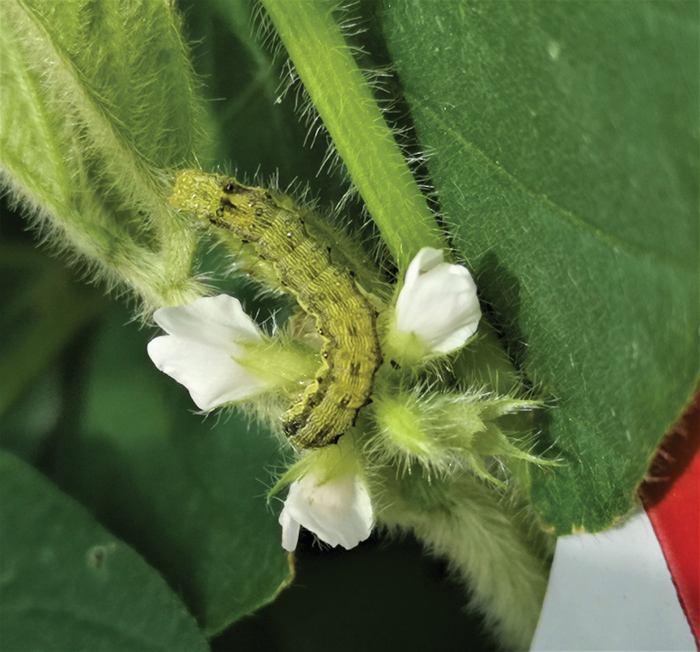
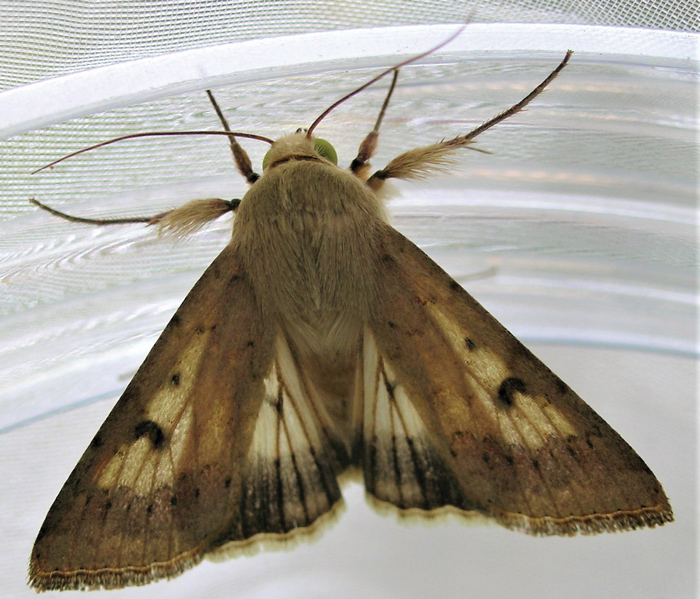
Bollworm larvae feed on the leaves and pods of the soybean plant. In older plants, pod damage translates into direct seed damage. Chemical control will be required whenever a large number of larvae are detected during the early pod-filling stage.
Soybean looper
(Thysanoplusia orichalcea)
Soybean looper larvae are bright to light green, up to 30 mm long and move with a characteristic double-folding action (Photo 3). Young larvae of this species feed on the leaves between the leaf veins. Older larvae cause holes in leaves and in the pods, which results in seed damage.
Looper moths can be identified by the large, almost triangular, golden/yellow patch located on each forewing. The rest of the moth’s body is brown and when in resting position, distinctive hairs on the upper body are visible (Photo 4). The use of insecticides is only considered during severe infestations.
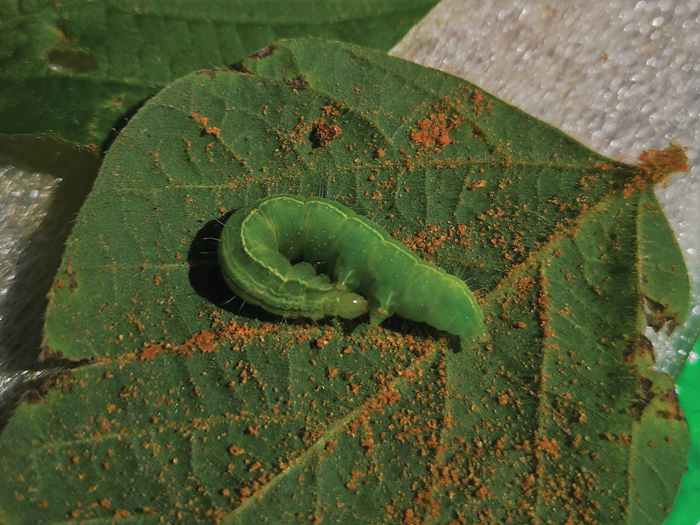
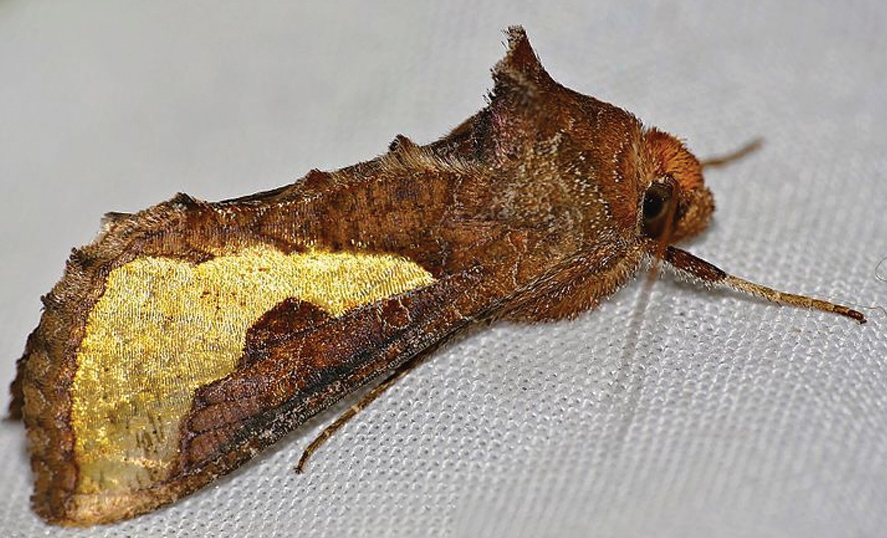
Fall armyworm
(Spodoptera frugiperda)
Fall armyworms feed on many crops including soybean. Very young fall armyworm larvae are green with a black head. Larvae appear olive to dark green and brown with lateral white/cream lines. The head is dark brown with a distinctive upside-down ‘Y’ between the eyes. The elevated black spots on the dorsal side of the body are usually visible, but the four black spots on the rear end are one of the most distinctive characteristic features of the fall armyworm (Photo 5). The male moth has a shaded forewing that ranges in colour between grey and brown, with a white patch at the tip, near the centre of the wing (Photo 6). Fall armyworm females are less distinctly marked and range from a uniform greyish to brown colour.
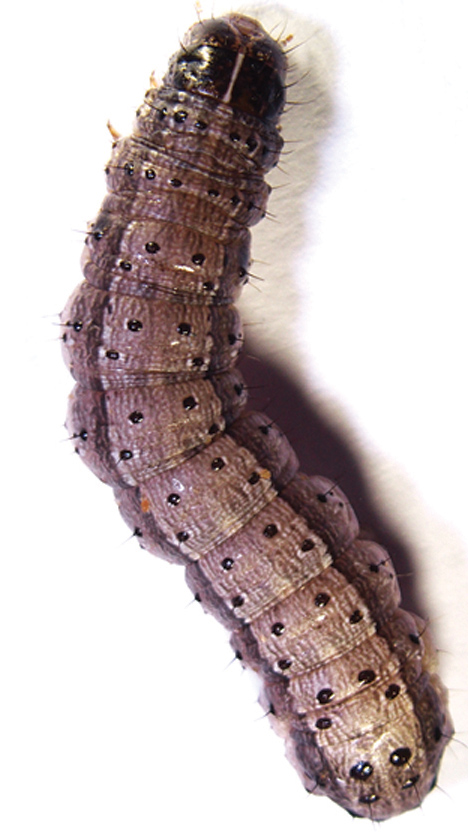
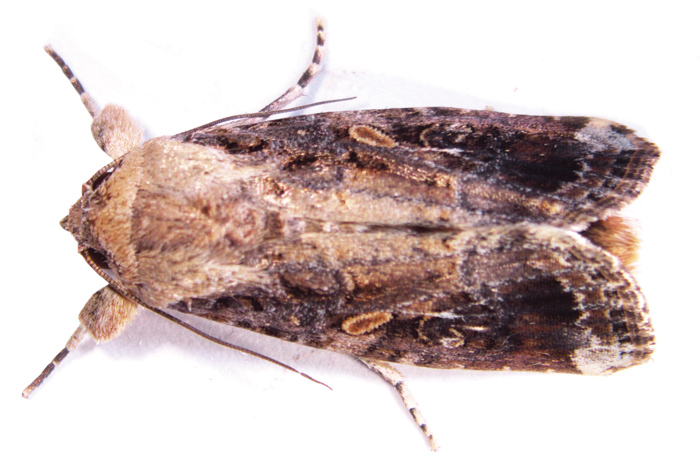
Fall armyworm larvae consume a significant amount of foliage when attacking seedlings and can reduce the plant population significantly. Economic thresholds, developed for this species on soybean, are based on the percentage defoliation. Insecticide application should already be considered when plants are heavily infested by small larvae, because older larvae are much more difficult to control.
Green stink bug (Nezara viridula)
Adult green stink bugs are recognised by their shield shape, are about 15 mm long and 8 mm wide and exude a foul-smelling scent. Bugs are usually green, but can also vary between yellow and brown to brown-green (Photo 7).
Nymphs as well as the adult insects of this species are pod and seed feeders. Pods are damaged when plant sap is sucked from them, which causes stippling marks. The feeding area of the insect becomes brown/darkened and hard (Photo 8). Uneven seed filling of some seeds in a damaged pod leads to quality loss. Chemical control is rarely required on a large scale, because contact insecticides sprayed for pests other than the green stink bug also suppress their numbers.
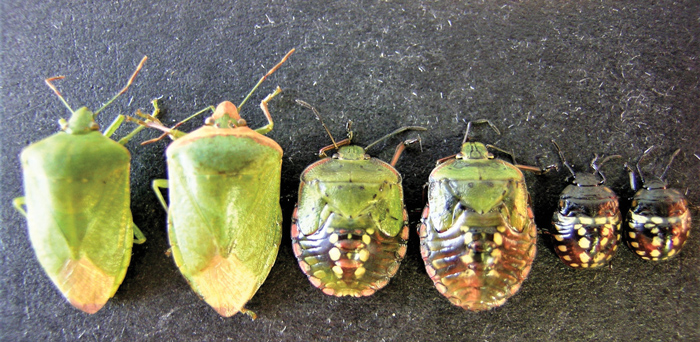
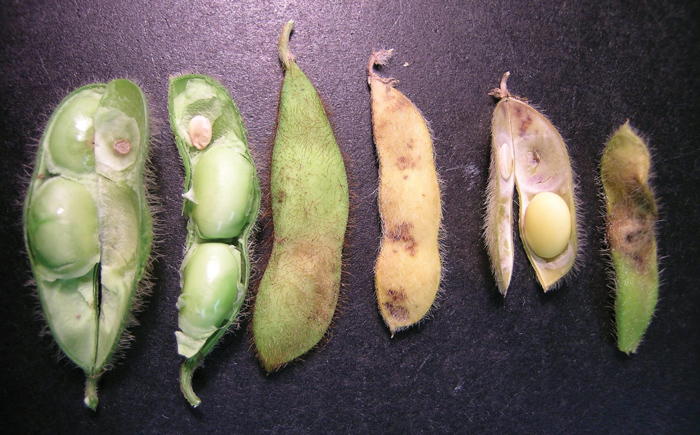
Painted lady (Cynthia cardui)
The larvae of this species appear dark grey/black with a yellow stripe on its backside. Spikes are visible on the sides and posterior end of the larva (Photo 9). The butterfly (adult) has characteristic orange, brown and black patches on the upper side of their wings. The tips of the wings have white patches closer to the edges/tips of the forewing and its wingspan is approximately 40 mm to 50 mm (Photo 10).
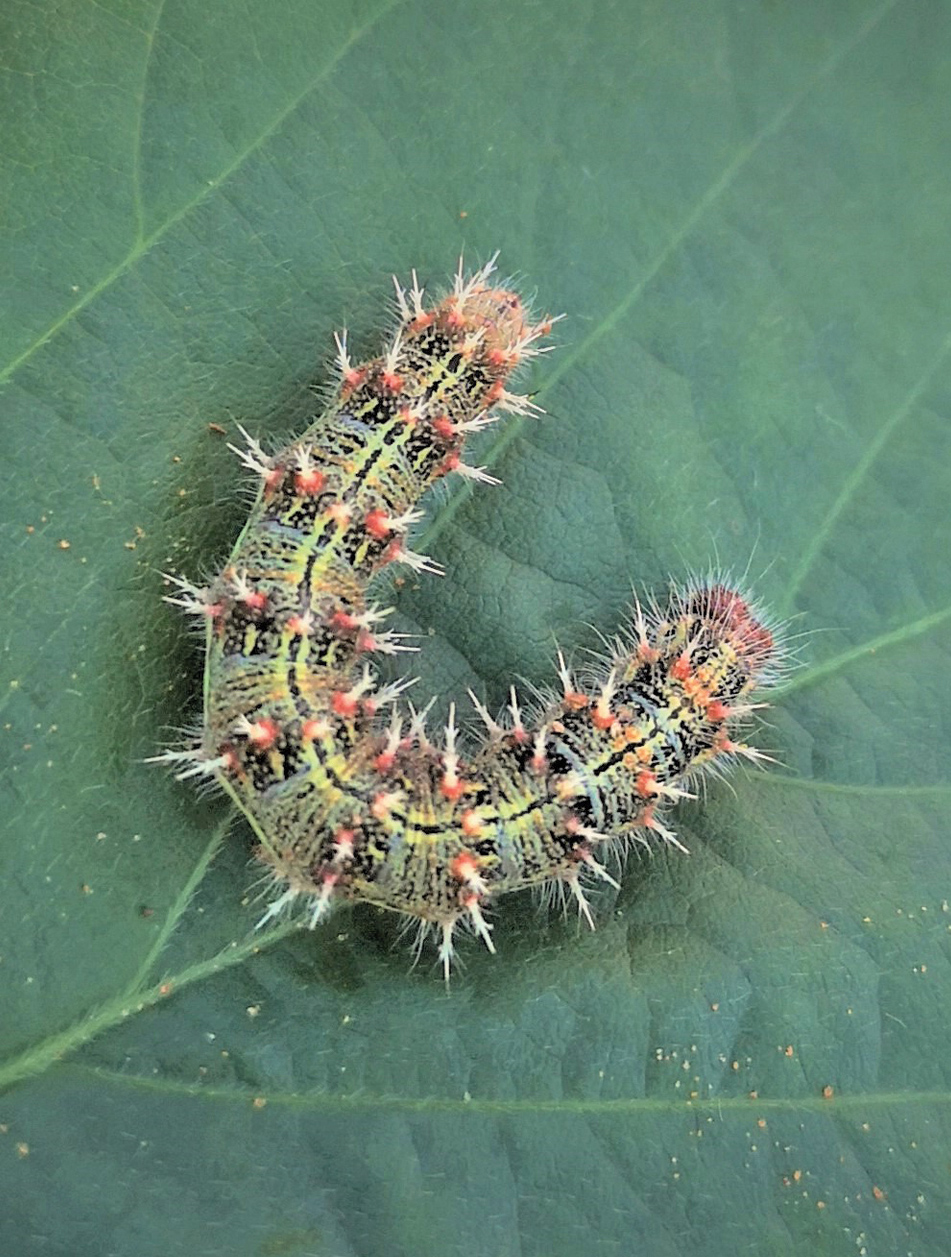
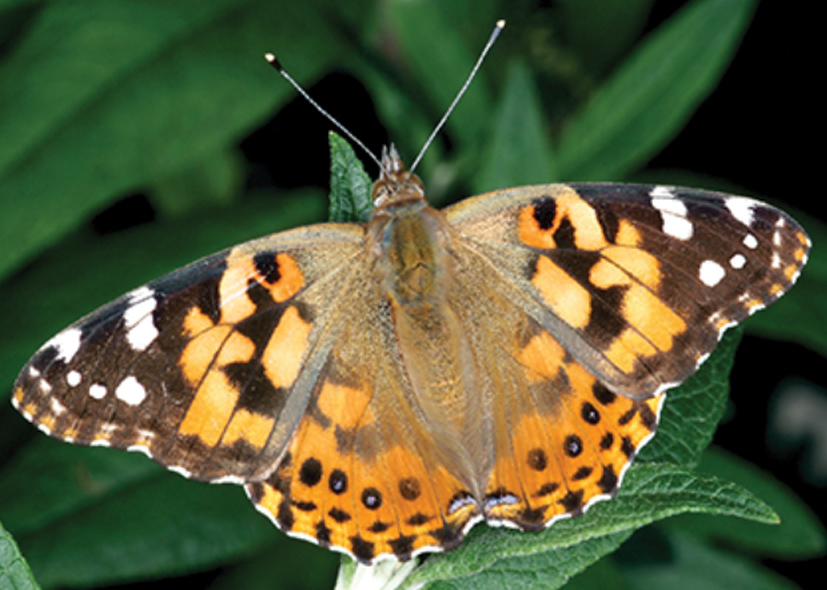
Source: (https://cropwatch.unl.edu/2017/large-populations-painted-lady-butterflies)
Larvae feed on leaves and in many instances spin together the leaves to each other or against the stems (Photo 11). The butterflies do not cause any damage to the plants, but will lay eggs on suitable host plants. Chemical control should be considered when more than six larvae are detected per meter on young plants.
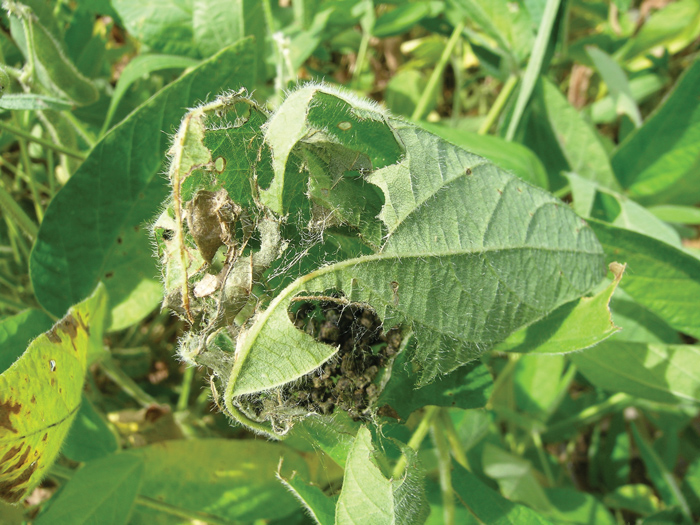
False wireworm (Somaticus spp.)
The larvae of this species are creamy white with a slender, hard/wirelike body and a reddish-brown head due to hairs on the side of the head. Larvae can grow up to 32 mm long and 4 mm thick (Photo 12). The beetles are known as toktokkies or surface/darkling beetles, which are grey-black with a distinctly demarcated head, chest and abdomen (Photo 13).
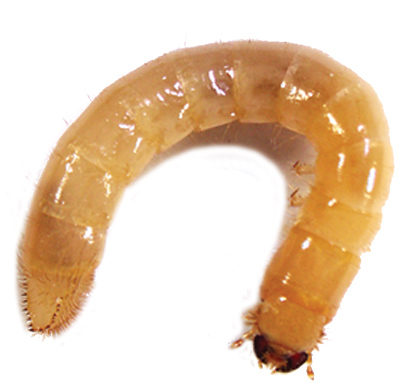
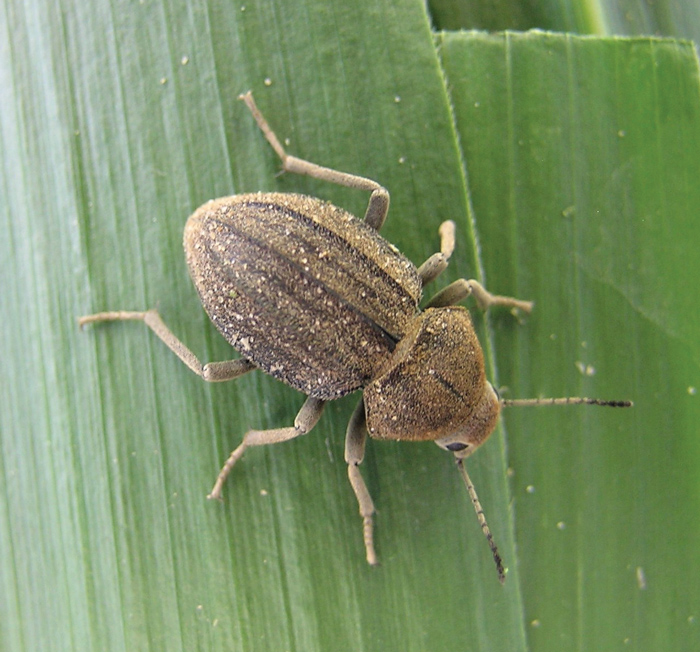
Larvae feed on seeds. The seeds can, in some instances, be completely hollowed out. They also feed on the small roots and on stems of developing seedlings just below the soil surface. Damaged young plants will appear stunted and wilted and the plant density can be considerably reduced. In the presence of rotted plant material in the soil, especially when weeds were ploughed in during autumn, these insects can be problematic. The beetles do not attack the crop plants to such an extent that control is needed.
IPM
Integrated pest management (IPM) is a strategy implemented to protect the producer against yield loss due to insect damage, weeds and diseases. IPM includes multiple strategies such as chemical and cultural methods to assist in pest control, reducing the potential for resistance development and bettering the use of available resources. The basic IPM strategy for soybean growers would be to use seed treatments and to scout for insects in the field. Insects observed during scouting should be correctly identified. It is important to apply insecticide timeously when required and to make use of cultural practices to prevent insect infestations in crop fields.
References
- Du Plessis, H. 2015. Grain legumes: cowpea, dry beans, pigeon pea and soybean. Insects of Cultivated Plants and Natural Pastures in Southern Africa. Hatfield, South Africa: Entomological Society of Southern Africa. p 785.
- ISAAA. 2020. ISAAA Brief 55-2019: Executive Summary. https://www.isaaa.org/resources/publications/briefs/55/executivesummary/default.asp Date of access: 2021/08/02.





























